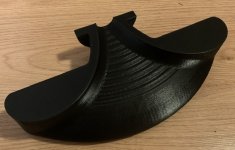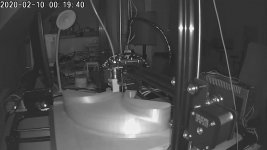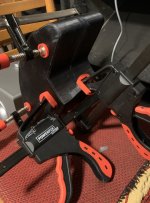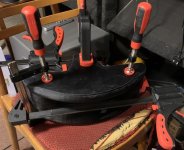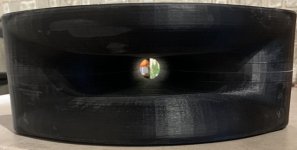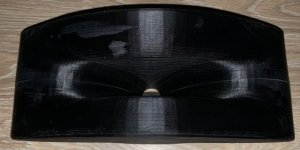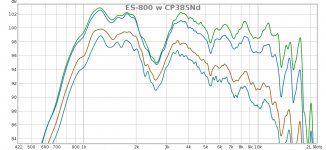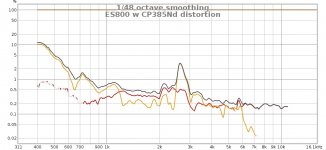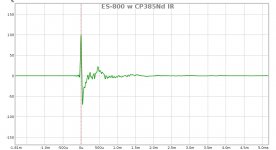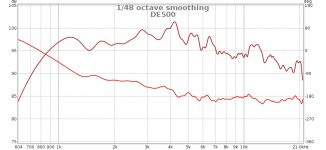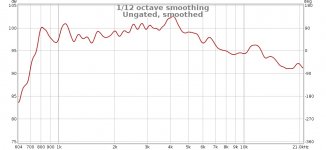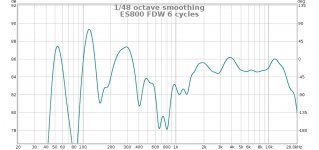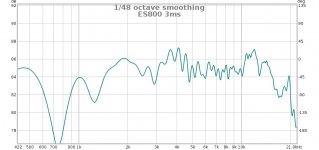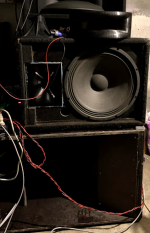I bought the 3D model from Joseph Crowe and now it is being printed. One half finished, second one will be finished in a few hours. My good old Beyma CP385Nds will be measured on this horn. One half uses ca 130 m of PLA filament and with 0.3 mm layer and 20% infill it takes about 15 hours to print. The bottom part on the first piece is slightly warped, but that is no big deal, since the top part is flat for glueing. The second one will be printed most probably with more infill so that I will use one spool for both halves. And it maybe will bend a bit less with more infil. Woden CNC'd would look better, but if I ever have these made, they would be the larger ES-600 for 1.4" driver, I have Beyma 755Nd on my shopping list
Attachments
Nice! I've been researching 3d printing, from my reading it seems PTEG is good material to use, low shrinkage. I also think that 3d printers are capable of printing horn geometries with ease. The horns I intend to print are much much bigger though. What has your experience been?
This is my biggest print so far. I use PLA, because it is cheap and the quality is fine. PETG would be a better choice, I plan to use that for the finals. I had the UICW printed by a friend from PETG.
Printing a horn like this in two halves works, sliced into more parts would need more attention to the warping. For larger horns, I actually consider printing a mold instead and make the horns from plaster.
Printing a horn like this in two halves works, sliced into more parts would need more attention to the warping. For larger horns, I actually consider printing a mold instead and make the horns from plaster.
The dimensions are ca 295 x 120 x 145 (WxHxD). I glued the halves with liquid nails - it took a while to align and clamp together, but the result is really good and will need only minimum of sanding and two layers of spray paint.
Attachments
So here the first measurements of the unfinished horn at different angles. The dip is most probably a result of imperfect seal at the throat, it still needs to be sanded and maybe thin gasket applied - I can see light around the flange when I put a LED torch in the throat.
I think this is brilliant. A pair including the price of model purchase and a large tube of liquid nails and some putty and spray paint will cost me around 45 bucks (second half of the second horn is in the print right now). A killer deal! These make me want to get the larger horns made in nice wood and using my favourite Beyma CP755Nd drivers.
I think this is brilliant. A pair including the price of model purchase and a large tube of liquid nails and some putty and spray paint will cost me around 45 bucks (second half of the second horn is in the print right now). A killer deal! These make me want to get the larger horns made in nice wood and using my favourite Beyma CP755Nd drivers.
Attachments
Last edited:
The second horn will not be that nice, one print failed due to a power dropout just before the last layer was finished. And the second one warped badly because I managed to misalign the printer a bit while trying to save the first print after the power failure. The inner part of the horn is OK, so now I am waiting for the glue to dry. The crossover will be at 1.2 kHz, as the measurements suggest (and Mr. Crowe as well).
Here is the second print that did not turn out so well, this time measured with a DE500 - which had a soft foam gasket on its face and also I worked a bit on the throat attachment to make it more flat. This time no crazy dips as expected and the ungated measurement shows response down to 800 Hz. With a bit of EQ, the end result should be nice.
Attachments
The second horn is finished and I made a quick listening test. Crossed over at 850 Hz to a 15" woofer. So far so good. It needs some adjustments to the EQ and I think I had the horns a few dB higher than they should be. Finally I found some use for the DE500s I had sitting in another box. Most probably the YS500 clone will be cannibalized more and the 15" Eminence will have a box made to go with these. Or I will see how these horns will work with the paraflex 1x12" kick that I will build.
Here are some measurements (in room, ca 1.2 m at 1 m height) with some EQ, bass horns and mid 15". I call this project a success. The DE500 is a good match for this horn. Very clean and detailed sound. Now the weak point is clearly the 15" midwoofer from a pair of old Peavey Eurosys 3 boxes. The overall sound would need more tuning and the horns would deserve also a less noisy amplifier, but so far so good!
A 12" midwoofer would be a better match and maybe even the H6000 horn with 8PE21 could work well below this horn, getting me back to 4 way Even as good as it is, I still somehow have preference for coaxial speakers - maybe it is just a colored memory, I need to compare them with the Beyma 12XA30 boxes side by side. And maybe it is the midwoofer that is the cause of preference.
Even as good as it is, I still somehow have preference for coaxial speakers - maybe it is just a colored memory, I need to compare them with the Beyma 12XA30 boxes side by side. And maybe it is the midwoofer that is the cause of preference.
The dispersion is narrowing slowly, and definitely a nice spot can be found that is not too small. I would say that the second weakest link is now the room arrangement, I need to work a bit on that. Also the crossover point is maybe a bit on the low side for the horn and driver combination.
A 12" midwoofer would be a better match and maybe even the H6000 horn with 8PE21 could work well below this horn, getting me back to 4 way
The dispersion is narrowing slowly, and definitely a nice spot can be found that is not too small. I would say that the second weakest link is now the room arrangement, I need to work a bit on that. Also the crossover point is maybe a bit on the low side for the horn and driver combination.
Attachments
PLA v PETG v plaster
A great approach
Why might you make a larger horns from plaster; and what is the benefit of PTG over PLA?
I imagine one important criteria is whether any of these materials resonate - have you experienced any of that with PLA? or did you apply some sort of external damping material?
I use PLA, because it is cheap and the quality is fine. PETG would be a better choice, I plan to use that for the finals. I had the UICW printed by a friend from PETG.
Printing a horn like this in two halves works. Sliced into more parts would need more attention to the warping.
For larger horns, I actually consider printing a mold instead and make the horns from plaster.
A great approach
Why might you make a larger horns from plaster; and what is the benefit of PTG over PLA?
I imagine one important criteria is whether any of these materials resonate - have you experienced any of that with PLA? or did you apply some sort of external damping material?
500 Hz exponential multicell horn for JBL2445 by pelanj - Thingiverse These were printed in around 60 parts. The thin wall definitely needs damping/extra mass, tar based car body paint is fine, there are many other options.
The multicell has a different purpose - and it needs a tweeter horn (also multicell - look for the Baby multicell thread ). The ES800 is great in a 2 way plus sub system. Most of the things I am doing at the moment are prototypes and things to try out. The multicell horn has a certain appeal to it, so does my Synergy horn prototype. Hard decisions
- Home
- Loudspeakers
- Multi-Way
- 3D printed biradial ES-800 horn by Joseph Crowe
